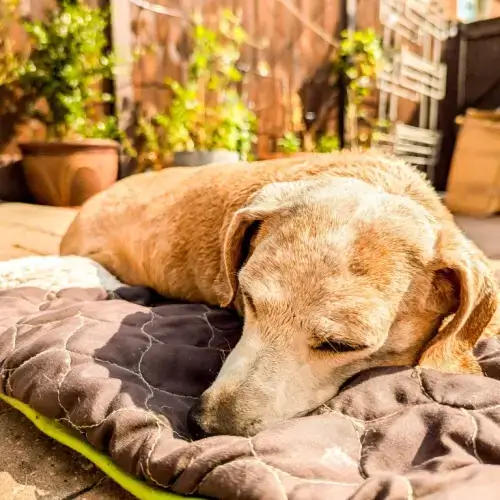Home / Compare Pet Insurance / Foods toxic to dogs

Key takeaways
- Many human foods, such as chocolate, grapes, and onions, can be toxic to dogs and cause serious health issues like organ failure.
- When exposed to harmful foods, dogs can show symptoms including vomiting, lethargy, seizures and irregular breathing. Early intervention is crucial to prevent long-term damage.
- Preventing food poisoning in dogs involves keeping toxic foods out of their reach, avoiding sharing human food, and educating family members and visitors about what the dogs can and cannot eat.
What are some human foods toxic to dogs?
Some human foods can harm dogs, and even a tiny amount of them may be life-threatening. Here are some common poisonous foods, their effects on dogs, and symptoms to watch out for.
Chocolates (dark chocolate and milk chocolate)
Effects on dogs:
- Theobromine and caffeine in chocolate stimulate the central nervous system and heart, which may cause low blood pressure1
- Potential liver failure in severe cases.
Symptoms:
- Restlessness, hyperactivity, vomiting, diarrhoea
- Rapid heart rate, tremors, seizures, and collapse.
Grapes and raisins
Effects on dogs:
- Kidney failure if too much is ingested1
- Severe dehydration and inability to filter toxins.
Symptoms:
- Vomiting (often within hours of ingestion)
- Lethargy, loss of appetite, excessive thirst, and reduced urination.
Onions and garlic
Effects on dogs:
- Damage to red blood cells, leading to anaemia2
- Reduced oxygen supply to tissues.
Symptoms:
- Vomiting, diarrhoea, lethargy, and pale gums
- Weakness, rapid breathing, and dark-coloured urine.
Xylitol (artificial sweetener)
Found in: Chewing gum, candy, baked goods, toothpaste, peanut butter (some)1
Effects on dogs:
- Rapid drop in blood sugar (hypoglycaemia)
- Liver damage and failure.
Symptoms:
- Vomiting, weakness, disorientation, and seizures.
- Jaundice (yellow gums or skin), and coma.
Alcohol
Effects on dogs:
- Ethanol present in alcohol can lead to central nervous system depression, causing irregular heart rhythm, and high blood pressure1
- Muscle tremors and seizures
- Severe dehydration and organ failure.
Symptoms:
- Vomiting, disorientation, and lack of coordination
- Slowed breathing, hypothermia, seizures, and coma.
Avocado
Effects on dogs:
- Persin (a compound present in avocados) can cause gastrointestinal upset2
- In rare cases, fluid may accumulate in the chest or around the heart.
Symptoms:
- Vomiting, diarrhoea, and abdominal pain
- Lethargy and difficulty breathing (in rare cases).
Macadamia nuts
Effects on dogs:
- Temporary muscular and nervous system1
Symptoms:
- Vomiting and weakness (especially in hind legs)
- Tremors, hyperthermia, and lethargy.
Bread dough (yeast dough)
Effects on dogs:
- Ethanol from fermentation can cause severe bloating in the digestive system2
- Alcohol poisoning can also occur due to the ethanol.
Symptoms:
- Abdominal swelling and vomiting
- Disorientation, tremors, seizures, and slowed breathing.
Fatty foods (e.g. fried foods like bacon)
Effects on dogs:
- High-fat content can cause painful inflammation of the pancreas (pancreatitis).2
Symptoms:
- Vomiting, diarrhoea, and loss of appetite
- Abdominal pain, lethargy, and dehydration.
Coffee and caffeine
Effects on dogs:
- Methylxanthines present in caffeine can cause overstimulation of the nervous and cardiac systems.1
Symptoms:
- Restlessness, panting, vomiting, and increased heart rate
- Tremors, seizures, and potential collapse.
Dairy products
Effects on dogs:
- Many dogs are lactose intolerant, which can cause an upset stomach1
Symptoms:
- Diarrhoea, bloating, gas, and abdominal discomfort.
Cooked bones
Effects on dogs:
- This choking hazard2 can cause internal injuries or blockages
- Intestinal perforation or blockages caused by splinters of bone.
Symptoms:
- Choking, vomiting, abdominal pain, and constipation
- Rectal bleeding or difficulty passing stools.
Raw meat and fish
Effects on dogs:
- Salmonella may be present in raw food if not handled or processed correctly and may cause food poisoning.2
Symptoms:
- Vomiting, fever, and swollen lymph nodes.
Recognising signs of poisoning in dogs
 Dogs may exhibit physical and behavioural changes when exposed to toxins. Common symptoms of poisoning include3
Dogs may exhibit physical and behavioural changes when exposed to toxins. Common symptoms of poisoning include3
- Gastrointestinal signs: Vomiting, diarrhoea, drooling, loss of appetite, abdominal pain
- Neurological signs: Tremors, seizures, unsteady gait, disorientation, unusual behaviour
- Respiratory signs: Laboured breathing, excessive panting, coughing
- Cardiovascular signs: Irregular heartbeat, pale or blue gums, lethargy
- Other signs: Excessive thirst or urination, jaundice (yellow gums or eyes), swollen abdomen, high body temperature.
Always consult your veterinarian if you suspect poisoning or are unsure about a food. Early recognition and intervention are essential for your furry friend and could save your dog’s life.
What should I do if my dog is poisoned?
- Stay calm: Act quickly but remain composed
- Identify the toxin: Check your surroundings for chewed packaging or food remnants
- Do not induce vomiting (unless advised): Some toxins can cause more harm if vomited
- Contact a veterinarian: Call your vet or a poison control hotline
- Follow instructions: Administer remedies like activated charcoal under your vet’s directions
- Transport to a vet: Take a sample of the suspected toxin for identification.
How to prevent food poisoning in dogs
- Dog-proof your home: Store toxic foods and substances out of reach
- Train your dog: Teach “leave it” commands to prevent scavenging
- Avoid sharing human food: Stick to vet-approved treats, dog food and diets
- Educate others: Inform family and visitors about foods that can harm dogs
- Supervise outdoor activities: Prevent ingestion of harmful plants or rubbish.
Pet Insurance for food poisoning
 Pet insurance can help cover the costs of treating dog food poisoning, including diagnostic tests, emergency care, medications, and hospitalisation. Most accident and illness plans cover poisoning as an unexpected event, while accident-only plans may cover toxic food ingestion but exclude illnesses like bacterial infections from spoiled food. However, pre-existing conditions or negligence (e.g. feeding your dog harmful foods) may be excluded.
Pet insurance can help cover the costs of treating dog food poisoning, including diagnostic tests, emergency care, medications, and hospitalisation. Most accident and illness plans cover poisoning as an unexpected event, while accident-only plans may cover toxic food ingestion but exclude illnesses like bacterial infections from spoiled food. However, pre-existing conditions or negligence (e.g. feeding your dog harmful foods) may be excluded.
Comprehensive policies that include accident and illness coverage offer the most comprehensive cover, but reviewing exclusions, waiting periods and coverage limits are essential before purchasing any pet insurance plan. Always read your Product Disclosure Statement (PDS) to ensure you know what the policy covers and the Target Market Determination (TMD) to work out whether the product suits you.
Meet our pet insurance expert, Adrian Taylor
As a General Insurance expert with over 13 years’ experience in financial services, Adrian Taylor knows that dogs and cats get themselves into all sorts of mischief. One part of Adrian’s work is to help empower consumers to understand how pet insurance can help save them from exorbitant vet bills when their pet gets injured or falls ill.
Want to know more about pet insurance?
1 Dogs Australia, Health and wellbeing: Toxic food for dogs. Accessed December 2024.
2 ASPCA. People foods to avoid feeding your pets. Accessed December 2024.
3 RSPCA UK. Common dog poisons. Accessed December 2024.



